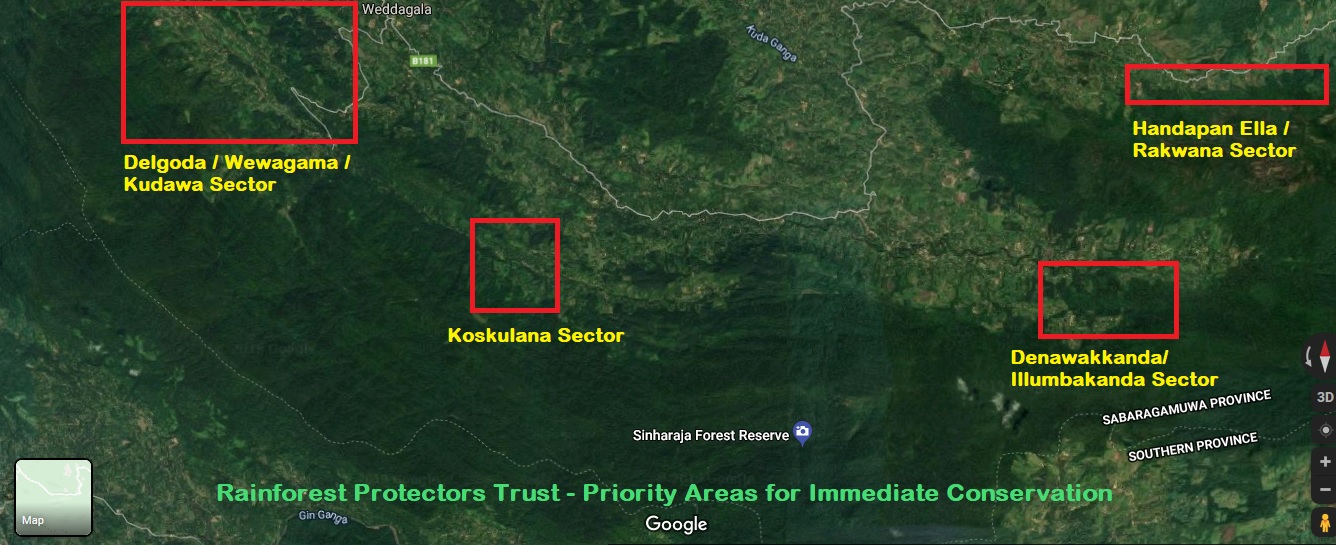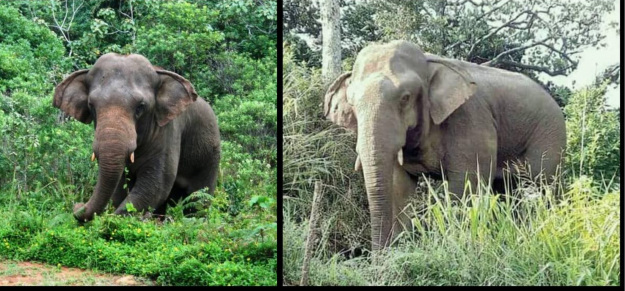Conservation Master Plan for Sinharaja World Heritage Rainforest
While 11,427 hectares has been declared as Sinharaja Rainforest by the Government of Sri Lanka,
UNESCO has designated a total of 29,830 hectares as Sinharaja World Heritage Rainforest which
includes an additional 16,316 hectares of rainforest designated as buffer zone and 2,087 hectares designated as transition zone.
While part of the forest area designated as buffer zone falls under Land Reforms Commission,
a large amount of forest land is under private ownership.
Vast majority of the forest lands under private ownership in Sinharaja falls along the northern boundary of Sinharaja World Heritage Rainforest and belonging to the Ratnapura District under Kalawana Divisional Secretariat and to a lesser extent Godakawela Divisional Secretariat. Rainforest Protectors Trust has identified over 600+ acres of such privately held rainforests that are being sold and based on many factors such as the importance of bio-diversity, elephant corridors, freshwater resources has categorized the areas into key sectors with the intent of focusing on protecting this key areas of forests.

Many acres of riverine rainforest land still exist in Sinharaja buffer zone under private ownership, and Rainforest Protectors Trust is dilligently working towards fundraising/purchasing and permanently protecting these riverine rainforests which provide vital habitat to many endemic flora & fauna as well as provide freshwater to wildlife and humans.

With no female elephant left and their migratory corridors cutoff by tea plantations, settlements and roads, the last 2 remaing rainforest elephants of Sinharaja are increasingly coming into conflict with humans. Therefore, Rainforest Protectors Trust is dilligently working to protect and rehabilitate their migratory elephant corridors through purchasing and permanently protecting privately held forest lands within the corridor under "Rainforest Protectors Trust" as well as reforesting degraded land. Additionally, we are in discussion with relevant Government authorities on the possibility of introducing a female elephant to reduce the need for the elephants to travel outside the forest boundary in search of mates.
Vast majority of the forest lands under private ownership in Sinharaja falls along the northern boundary of Sinharaja World Heritage Rainforest and belonging to the Ratnapura District under Kalawana Divisional Secretariat and to a lesser extent Godakawela Divisional Secretariat. Rainforest Protectors Trust has identified over 600+ acres of such privately held rainforests that are being sold and based on many factors such as the importance of bio-diversity, elephant corridors, freshwater resources has categorized the areas into key sectors with the intent of focusing on protecting this key areas of forests.

A rainforest without a river?
Despite thousands of streams originating from Sinharaja World Heritage Rainforest feeding many rivers such as Gin Ganga (river), Kudawa river, Koskulana river, Delgoda river, severe deforestation and encroachment during the last century coupled with lack of Government initiatives to protect riverine rainforest ecosystems, Sinharaja World Heritage Rainforest has lost all its rivers which now flow outside its boundary within residential areas. This has resulted in further deterioration of the most important ecosystem, due to destructive actvities such as mini-hydro projects, sand mining and tea plantations which has encroached upon the river buffer zones illegally despite the protections granted to river buffer zones through State Land Ordinance of 1947 No 8.Many acres of riverine rainforest land still exist in Sinharaja buffer zone under private ownership, and Rainforest Protectors Trust is dilligently working towards fundraising/purchasing and permanently protecting these riverine rainforests which provide vital habitat to many endemic flora & fauna as well as provide freshwater to wildlife and humans.
Home of the last two lowland rainforest elephants in Sri Lanka
A century ago, hundreds of elephants roamed the vast contiguous lowland rainforests of Sri Lanka. But with the introduction of tea plantations during the British Colonial period, thousands of pristine acres of rainforests were cut down resulting in severe fragmentation of elephant corridors. Subsequent rapid deforestation after gaining independence due to expanding tea plantations as well as expansion of human settlements and roads resulted in all elephant corridors in the lowland rainforests in Sri Lanka being cut off. Such destruction reduced the number of herds to just two, numbering less than 100 elephants between Sinharaja and Kanneliya rainforests. By the 70s, Kanneliya rainforest lost all its elephants with just a small herd of 8 to 10 elephants remaining in Sinharaja. As of 2019, only 2 elephants remain in Sinharaja, both males from the same mother, ardently known as Loku Aliya and Panu Kota. Genetically, behaviorally and structurally different from their dry zone cousins, the rainforest elephants of Sinharaja have been observed travelling approximately 15km to 20km daily, frequently moving between the fragmented rainforests within Northern Sinharaja, namely Delwala-Walankanda forest reserve, Kudumeeriya forest reserve and to the east the Rakwana hills.
With no female elephant left and their migratory corridors cutoff by tea plantations, settlements and roads, the last 2 remaing rainforest elephants of Sinharaja are increasingly coming into conflict with humans. Therefore, Rainforest Protectors Trust is dilligently working to protect and rehabilitate their migratory elephant corridors through purchasing and permanently protecting privately held forest lands within the corridor under "Rainforest Protectors Trust" as well as reforesting degraded land. Additionally, we are in discussion with relevant Government authorities on the possibility of introducing a female elephant to reduce the need for the elephants to travel outside the forest boundary in search of mates.

